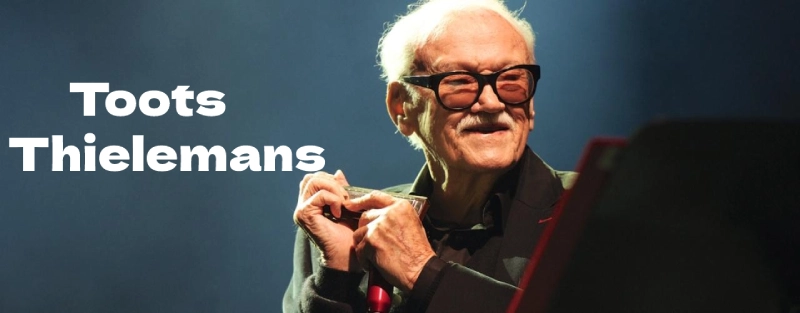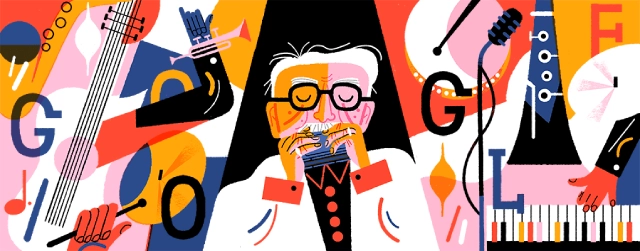Festivals & Events
Interesting Facts about Belgian Jazz Musician Toots Thielemans

Search engine giant Google celebrates Belgian jazz musician Toots Thielemans’ 100th birthday on April 29, 2022. The current Google Doodle — represented by guest artist Melissa Crowton — hits the proper notes by celebrating Toots Thielemans’ dedications to the jazz world on what may be his 100th birthday. Here are some interesting and fun facts about Toots Thielemans you should need to know.

Google Doodle on Toots Thielemans’ 100th Birthday
Here is a look at the life and work of Toots Thielemans.
Personal
- Birth name: Jean-Baptiste Frédéric Isidor, Baron Thielemans
- Birthdate: 29 April 1922
- Birthplace: Brussels, Belgium
- Died on: 22 August 2016 (aged 94)
- Death place: Braine-l’Alleud, Belgium
- Father name: Bernard Thielemans
- Mother name: Armance Demaesschalck
- Spouse(s): Huguette Tuytschaever
- Nationality: Belgian
- Famous as: Musician, composer
- Notable award: NEA Jazz Masters
40 Interesting and Fun Facts about Toots Thielemans
- Toots Thielemans was born Jean-Baptiste Thielemans in Brussels, Belgium, on April 29, 1922, and was playing the accordion by the age of three. While in his teens, before he even realized what jazz was, he purchased his first harmonica.
- Preceding World War II, Toots Thielemans had seen movies with legendary harmonica player Larry Adler “playing light classical things.” He paid attention to American swing records with his companions, who later named him “Toots” since they felt that “Jean just didn’t swing.” They urged him to play his harmonica with their band, and when they perceived how gifted he was they proposed that he attempt a real instrument, similar to the guitar.
- In 1949 Toots Thielemans joined a jam session in Paris with Sidney Bechet, Charlie Parker, Miles Davis, Max Roach, and others.
- Toots Thielemans inclined toward the American bebop sound during the 1940s. After World War II finished, he worked as an accompanist to headliners like Edith Piaf and Charles Trenet in Brussels. By the 1950s he was playing all over Europe with Benny Goodman, Roy Eldridge, and Zoot Sims.
- During a visit to the U.S. in 1948, a specialist of Benny Goodman heard him play at a small New York music club. Not long after he got back to his home in Belgium, he got a letter inviting him to join Goodman’s band while they toured in Europe, which he promptly acknowledged and joined their tours in 1949 and 1950.
- During the tour, Goodman was “shocked” when he discovered that these tours were whenever Toots Thielemans first had brought in cash from his playing. Even though Thielemans was hired on as a guitarist, when Goodman’s group debuted at the London Palladium, he played the harmonica because of union limitations.
- During those years, Toots Thielemans likewise made his first record with fellow band member, tenor saxophonist Zoot Sims. In 1951 he toured with singer-songwriter and comrade Bobbejaan Schoepen, performing stringently as a guitarist.
- In 1952 Thielemans moved to the United States. He had stuck with Charlie Parker while in Sweden, and for one memorable week in 1952, he joined Bird’s All-Stars at the Earle Theatre in Philadelphia.
- Toots Thielemans moved to the United States in 1952 where he was a member of Charlie Parker’s All-Stars and worked with Miles Davis and Dinah Washington. In 1957 he became a U.S. citizen.
- He first heard the faster bebop style of jazz from records by Parker and Dizzy Gillespie after they had arrived in Belgium after the war. They became his musical “prophets.”
- From the latter part of 1952 to mid-1959, Toots Thielemans played with pianist George Shearing. It was the only stable job he ever had. It was during this time that he became companions with Bill Evans and Quincy Jones, recording some of his favorite tunes with them.
- From 1953 to 1959 he played guitar and harmonica with the George Shearing Quintet. With Shearing, he added whistling to his collection. When on tour with Shearing, while at the same time playing in Hamburg in 1960, he was seen by a young musician and observer (John Lennon) that Toots played a Rickenbacker guitar.
- In 1955, Toots Thielemans recorded his first album as a bandleader, “The Sound.” During the 1950s, Thielemans had ruled the “miscellaneous instrument” category in Down Beat magazine’s poll.
- From 1959 on he toured internationally with his small group alongside intermittently recording in the studio. He recorded with singers and musicians. Thielemans says that his recording with Evans’ trio, Affinity, (1979) was one of his top picks.
- Toots Thielemans stated “Bluesette,” a jazz standard, which he performed on harmonica or while playing the guitar and whistling as one. First recorded by him in 1962, with lyrics added by Norman Gimbel, the song became a major worldwide hit. It has since been covered by over one hundred artists.
- He worked both as a bandleader and as a sideman, incorporating many projects with composer/arranger Quincy Jones. During the 1960s he performed on TV with Peggy Lee. In 1969 he recorded “Honeysuckle Rose Aquarela Do Brasil” with singer Elis Regina and performed with her on the Swedish TV special.
- By the mid-1960s, Toots Thielemans had become progressively famous in the studios as a harmonica player and whistler. In 1963 Thielemans broke however to a worldwide audience with his composition “Bluesette.”
- During his career, Toots Thielemans performed on many film soundtracks, like The Pawnbroker (1964), Midnight Cowboy (1969), The Getaway (1972), Turkish Delight (1973), Cinderella Liberty (1973), The Sugarland Express (1974), The Yakuza (1974), Looking for Mr. Goodbar (1977), The Wiz (1978), Jean de Florette (1986), and French Kiss (1995).
- He likewise played the highlighted solo in the theme for PBS-TV’s classic children’s show Sesame Street. His theme for the popular Sesame Street TV show was heard for 40 years.
- Toots Thielemans’ music was heard on the Belgian TV series Witse, and in the Netherlands, for the Baantjer program. He made the music for the 1974 Swedish film Dunderklumpen!, in which he additionally gave the voice of the animated character Pellegnillot.
- His whistling and harmonica playing was heard in Old Spice commercials during the 1960s. He played harmonica on “Night Game” on Paul Simon’s 1975 album Still Crazy After All These Years.
- Toots Thielemans’ advantage in international music extended over the next decade. He had first been acquainted with Brazilian music in the mid-1960s through Stan Getz and was allowed the opportunity to partake in a Brazilian music session in 1972.
- Whenever the opportunity emerged to do an album with singer Elis Regina — she is frequently named “Brazil’s Billie Holiday” — Toots Thielemans was prepared to immerse himself in the undertaking. Working on the album prepared for his entry onto the Brazilian music scene; from that point forward, the music of the country has been his passion.
- Toots Thielemans has been included on recordings with contemporary artists like Billy Joel, Paul Simon, Quincy Jones, Pat Metheny, and Ella Fitzgerald. Also, even though he is a skilled guitarist and an outstanding whistler, his harmonica playing is unmatched.
- During the mid-1980s, he was a visitor various times on Late Night with David Letterman. He has performed with the bassist Jaco Pastorius, and in 1983 he added to Billy Joel’s album An Innocent Man, with the song, “Leave A Tender Moment Alone.” after a year, he showed up on the Julian Lennon song “Too Late for Goodbyes” from the album Valotte.
- In 1984, Toots Thielemans recorded with Billy Eckstine on the singer’s final album (I Am a Singer), including ballads and standards organized and directed by Angelo DiPippo. During the 1990s, Thielemans set out on theme projects that included world music. In 1998 he released a French-flavoured album named Chez Toots including guest singer Johnny Mathis.
- During those years, Toots Thielemans frequently recorded songs as personal tributes to the people who were influential during his career. On Chez Toots, for example, he included “Dance For Victor,” which he dedicated to his occasional keyboard accompanist, Victor Feldman. Likewise, he recorded “Waltz for Sonny” as a tribute to saxophonist Sonny Rollins.
- In June 1998, at Germany’s Jazzbaltica, he honored Frank Sinatra who died a month sooner. Furthermore, during the first Caspian Jazz and Blues Festival in Azerbaijan in 2002, he played out his recorded version of “Imagine,” his tribute to its writer, John Lennon.
- Toots Thielemans was popular for his modesty and kind demeanor in his native Belgium and was referred to for depicting himself as a Brussels “ket,” which signifies “street kid” in old Brussels slang.
- He got a joint honorary doctorate from the Université libre de Bruxelles and the Vrije Universiteit Brussel, Belgium. In 2001, Thielemans was raised into the Belgian respectability by King Albert II and given the honorable title Baron for life, in acknowledgment of his contribution to music.
- In 2006 Toots Thielemans was honored by an all-star tribute concert for him at Carnegie Hall. Piano player Herbie Hancock and clarinetist Paquito D’Rivera were among the performers. In 2009, he was given the highest U.S. honor that can be agreed to a jazz musician, the qualification of “Jazz Master,” by The National Endowment for the Arts.
- Toots Thielemans was nominated for the title of the Greatest Belgian in 2005. In the Flemish version, he completed in 20th place, and in the Walloon version, he came 44th.
- On 23 January 2009, he joined guitarist Philip Catherine on stage at the Liberchies church (Belgium) in memory of the 100th anniversary of the birth of Django Reinhardt.
- In 2012, the Jazz at Lincoln Center concerts in New York celebrated Toots Thielemans’ 90th birthday celebration with, among others, Herbie Hancock, Eliane Elias, and Kenny Werner. He performed for the event and left the stage standing among his companions.
- Because of health problems that prompted show cancellations, Thielemans reported his retirement on 12 March 2014, canceling all scheduled concerts. His supervisor stated that Thielemans “wants to enjoy the rest he deserves.” However, he did make one more stage appearance, unannounced, in August 2014, at the Jazz Middelheim Festival in Antwerp.
- Toots Thielemans died on 22 August 2016 in Braine-l’Alleud (Eigenbrakel), Belgium, at the age of 94.
- After the declaration, the Netherlands-based jazz and pop orchestra Metropole Orkest, alongside American trumpet player Quincy Jones, performed at London’s Royal Albert Hall in Toots Thielemans’ honor. One more concert was performed at the Brussels’ Grand Place.
- Toots Thielemans was buried on the 27th of August in La Hulpe, just outside Brussels. Pianist Kenny Werner read a personal message by U.S. President Barack Obama for his widow, Huguette.
- In December 2016, the Music Division of the Royal Library of Belgium gained the Toots Thielemans Collection. The collection comprises many sound recordings (78 rpm, vinyl records, and CDs) and a huge number of documents, for example, photos, press articles, scores, letters, and concert programs.
- On April 29, 2022, Google featured Doodle on its homepage for celebrating Toots Thielemans’ 100th birthday.
-
Health3 weeks ago
Back to Roots: Ayurveda Offers Natural Cure for Common Hair Woes
-

 Tech3 weeks ago
Tech3 weeks agoFrom Soil to Silicon: The Rise of Agriculture AI and Drone Innovations in 2025
-

 Science7 days ago
Science7 days agoJuly Full Moon 2025: Everything You Should Need to Know, When and Where to See Buck Moon
-

 Sports3 weeks ago
Sports3 weeks agoFIBA 3×3 World Cup 2025: Full Schedule, Preview, and How to Watch
-

 Gadget4 weeks ago
Gadget4 weeks agoThings to Know about Samsung Galaxy S26: What’s New and What’s Next
-

 Tech4 weeks ago
Tech4 weeks agoAdobe Firefly App Now Available on iOS and Android Phones to Create AI Images and Videos Anywhere
-

 Sports2 weeks ago
Sports2 weeks agoPrefontaine Classic 2025: Full Schedule, Preview, Field, Events and How to Watch Diamond League Eugene Live
-

 Festivals & Events3 weeks ago
Festivals & Events3 weeks agoEverything You Should Need to Know about Summer Solstice 2025

























